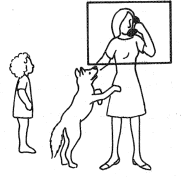How to Direct Audience Attention
There are certain dictums in shot organization. Every shot should have a purpose, however broad. It usually has a particular center of interest. It will normally continue a foregoing theme or argument, until we want to change to a new one. If we wish to convey specific ideas, we must discourage random thought-wandering. In an advertisement for floor polish, we do not want people distracted by costume, decor, and similar side issues. How do we achieve this?
Methods of directing attention
Fundamentally, we can cause the subject to attract the eye, or ensure that other aspects do not – i.e. form a neutral accompaniment.
We can direct attention to particular features in various ways.
• Exclusion. Take close shots. Avoid unwanted subjects. Simplify backgrounds.
• Visual direction. Pointing with a finger, pointer, inserted arrow or circle.
• Aural indication. A speaker draws attention to particular items/features.
• Lighting treatment. Localized lighting; other subjects half-lit.
• Composition. Using convergent line or pattern, balance, prominence through scale.
• Color. Using prominent hues against neutral or pastel hues. Using vibrant and discordant-colors.
• Camerawork. By differential focusing, perspective, viewpoint, camera movement
• Subject movement. Movement attracts, according to the speed, strength, direction of motion.
Look out for distractions
So you see, there are many varied ways in which we can attract and hold audience attention, but you can also see how easily attention can be distracted. If, for example, a person within a background group is dressed in startling contrast to others, or fluttering a fan, a director will often exclude them, rather than let attention be drawn away from the main foreground subject.
Varying concentration
You should aim to vary the audience’s concentration pattern to suit the program material. Some shots say, ‘I particularly want you to note this point’, while others encourage the viewers to look around or reflect a little, or may provide a shot of a general nature that enables them to concentrate on the audio instead (i.e. listening to commentary, dialogue, music). But do not attempt to sustain concentration for too long, or interest will fall, and minds wander.
Exclusion
By keeping other items out of shot, attention can be concentrated on the main sybject.

Visual direction
Where rapid, unambiguous identification is essential, an Indicator or marker (circle, arrow) is invaluable.

Isolation by lighting
Lighting can be arranged to isolate the required sybject.

Composition
Here the eye is drawn to the main sybject. The others serve as a visual support.

